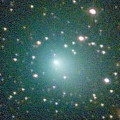
|
Now it is bright as 8.3 mag (Sept. 20, Maik Meyer). It stays bright as 8-9 mag until October. It moves southwards very rapidly after this. In the Southern Hemisphere, it becomes observable in excellent condition after this. In the Northern Hemisphere, it will be getting lower after this, and it will be unobservable in November.
Date(TT) R.A. (2000) Decl. Delta r Elong. m1 Best Time(A, h)
Sept.21 0 50.01 32 47.1 0.537 1.471 143 8.7 0:57 ( 0, 89)
Sept.28 23 51.11 12 39.8 0.495 1.489 167 8.6 23:19 ( 0, 66)
|
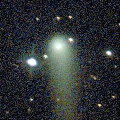
|
Now it is 11.6 mag (Sept. 11, Maik Meyer). It stays bright as 11 mag until winter. It stays observable in good condition for a long time in the Northern Hemisphere. In the Southern Hemisphere, it will be getting lower gradually, and it will be unobservable in early December.
Date(TT) R.A. (2000) Decl. Delta r Elong. m1 Best Time(A, h)
Sept.21 2 11.09 29 22.3 2.375 3.164 134 11.4 2:15 ( 0, 84)
Sept.28 1 59.31 31 22.2 2.306 3.154 141 11.3 1:36 ( 0, 86)
|
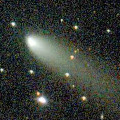
|
Now it is 11.6 mag (Sept. 9, Seiichi Yoshida). It stays 12 mag until November. It is observable in excellent condition in the Northern Hemisphere. It will be extremely low after October in the Southern Hemisphere.
Date(TT) R.A. (2000) Decl. Delta r Elong. m1 Best Time(A, h)
Sept.21 2 43.91 33 28.4 0.572 1.422 126 11.6 2:47 ( 0, 88)
Sept.28 2 48.90 37 27.7 0.564 1.431 129 11.5 2:25 (180, 88)
|
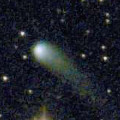
|
Now it is 12.2 mag (Sept. 11, Maik Meyer). It is expected to brighten up to 8 mag in 2020. It stays observable in good condition for a long time in the Northern Hemisphere. In the Southern Hemisphere, it will be getting lower gradually, and it will be unobservable in early December.
Date(TT) R.A. (2000) Decl. Delta r Elong. m1 Best Time(A, h)
Sept.21 5 32.49 25 41.5 3.026 3.249 93 12.3 4:22 (295, 72)
Sept.28 5 35.75 26 56.4 2.855 3.182 99 12.1 4:27 (308, 78)
|

|
It has not been observed yet in this apparition. Now it is fainter than 21.5 mag (Aug. 4, Erwin Schwab). It was expected to brighten up to 12 mag from August to September. But actually, it must be much fainter than expected. It is observable in good condition in the Northern Hemisphere. In the Southern Hemisphere, it will be unobservable soon.
Date(TT) R.A. (2000) Decl. Delta r Elong. m1 Best Time(A, h)
Sept.21 5 56.91 45 40.6 1.094 1.462 88 12.2 4:22 (233, 69)
Sept.28 6 17.56 47 48.9 1.089 1.493 90 12.5 4:27 (225, 70)
|
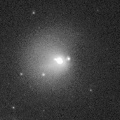
|
Now it is 13.3 mag (Sept. 6, Ken-ichi Kadota).
Date(TT) R.A. (2000) Decl. Delta r Elong. m1 Best Time(A, h)
Sept.21 0 49.43 16 3.1 4.833 5.774 157 13.1 0:53 ( 0, 71)
Sept.28 0 46.31 15 50.7 4.805 5.775 164 13.1 0:22 ( 0, 71)
|

|
It brightened rapidly. Now it is very bright as 11.5 mag (Sept. 3, Chris Wyatt). It may fade out rapidly after this. In the Southern Hemisphere, it stays observable in the low sky until it becomes fainter than 18 mag in winter. It is not observable at all in the Northern Hemisphere.
Date(TT) R.A. (2000) Decl. Delta r Elong. m1 Best Time(A, h)
Sept.21 10 39.69 -52 41.3 1.968 1.630 55 13.4 4:22 (316,-30)
Sept.28 11 20.62 -56 27.7 2.021 1.678 55 13.8 4:27 (320,-32)
|
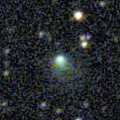
|
Now it is 13.3 mag (Sept. 16, Chris Wyatt). It is observable at 13.5 mag in good condition in autumn.
Date(TT) R.A. (2000) Decl. Delta r Elong. m1 Best Time(A, h)
Sept.21 18 2.23 -12 40.8 1.516 1.862 93 13.8 19:23 ( 25, 39)
Sept.28 18 15.04 -13 32.5 1.559 1.845 89 13.8 19:13 ( 26, 37)
|

|
Now it is 13.9 mag (Sept. 5, Chris Wyatt). It stays 13-14 mag for a long time in 2019. In the Southern Hemisphere, it is observable in good condition. In the Northern Hemisphere, it is not observasble until summer in 2020.
Date(TT) R.A. (2000) Decl. Delta r Elong. m1 Best Time(A, h)
Sept.21 9 45.54 -75 34.1 3.114 3.079 78 14.0 4:22 (343,-32)
Sept.28 10 9.76 -78 27.4 3.131 3.091 78 14.0 4:27 (347,-32)
|

|
Now it is 14.7 mag (Sept. 6, Ken-ichi Kadota). It is observable at 14 mag in good condition in autumn.
Date(TT) R.A. (2000) Decl. Delta r Elong. m1 Best Time(A, h)
Sept.21 8 24.44 14 6.4 2.903 2.428 52 14.0 4:22 (275, 31)
Sept.28 8 35.23 13 15.8 2.860 2.457 56 14.1 4:27 (279, 35)
|

|
It brightened up to 7.7 mag in June in 2018 (June 19, Juan Jose Gonzalez). Now it is fading. It has already faded down to 14.3 mag (Aug. 24, Thomas Lehmann). In the Southern Hemisphere, it stays observable for a long time until the comet will fade out. In the Northern Hemisphere, it is appearing in the morning sky, but it stays low for a while.
Date(TT) R.A. (2000) Decl. Delta r Elong. m1 Best Time(A, h)
Sept.21 7 4.07 -30 46.6 4.963 4.799 74 14.5 4:22 (324, 14)
Sept.28 7 4.55 -31 18.2 4.952 4.856 78 14.5 4:27 (331, 17)
|
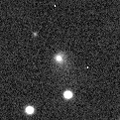
|
Now it is 14.0 mag (Sept. 5, Chris Wyatt). In the Southern Hemisphere, it is observable for a long time. It stays low in the Northern Hemisphere.
Date(TT) R.A. (2000) Decl. Delta r Elong. m1 Best Time(A, h)
Sept.21 23 24.35 -44 1.2 3.610 4.394 136 14.5 23:24 ( 0, 11)
Sept.28 23 17.01 -43 7.0 3.674 4.421 133 14.6 22:49 ( 0, 12)
|
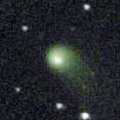
|
Now it is 14.8 mag (Aug. 28, Chris Wyatt). It will be fading slowly after this. In the Southern Hemisphere, it stays observable in good condition for a long time, although it becomes low from October to November. It will never be observable after this in the Northern Hemisphere.
Date(TT) R.A. (2000) Decl. Delta r Elong. m1 Best Time(A, h)
Sept.21 13 41.94 -44 56.0 4.522 3.985 52 15.3 19:23 ( 49,-21)
Sept.28 13 45.11 -45 37.7 4.622 4.022 48 15.4 19:13 ( 49,-23)
|
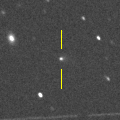
|
Now it is 15.5-16.0 mag (Sept. 8, Koremasa Hirofumi). It stays 15.5 mag until December, and it is observable in good condition.
Date(TT) R.A. (2000) Decl. Delta r Elong. m1 Best Time(A, h)
Sept.21 23 56.67 -8 16.3 1.540 2.539 172 15.8 0:01 ( 0, 47)
Sept.28 23 53.01 -8 49.2 1.528 2.517 168 15.7 23:25 ( 0, 46)
|
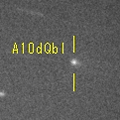
|
Now it is 15.8 mag (Aug. 26, Toshihiko Ikemura, Hirohisa Sato). It stays observable in good condition while the comet will be fading slowly after this.
Date(TT) R.A. (2000) Decl. Delta r Elong. m1 Best Time(A, h)
Sept.21 3 31.20 6 0.4 1.576 2.299 124 15.9 3:34 ( 0, 61)
Sept.28 3 33.44 4 53.5 1.558 2.337 130 15.9 3:09 ( 0, 60)
|
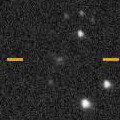
|
Now it is 15.0 mag (July 21, Taras Prystavski). It stays 16 mag for a long time from 2019 to 2020. It stays observable for a long time in the Southern Hemisphere. It is hardly observable in the Northern Hemisphere.
Date(TT) R.A. (2000) Decl. Delta r Elong. m1 Best Time(A, h)
Sept.21 11 36.70 -60 9.0 3.879 3.508 61 15.9 4:22 (323,-39)
Sept.28 11 44.17 -61 42.2 3.882 3.496 60 15.9 4:27 (325,-36)
|
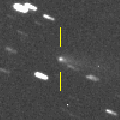
|
Now it is 15.9 mag (Sept. 6, Ken-ichi Kadota). It is observable at 16 mag in good condition from summer to autumn. It locates somewhat low in the Southern Hemisphere.
Date(TT) R.A. (2000) Decl. Delta r Elong. m1 Best Time(A, h)
Sept.21 3 44.71 28 29.1 1.494 2.143 116 15.9 3:48 ( 0, 84)
Sept.28 3 47.39 28 52.2 1.447 2.162 122 15.9 3:23 ( 0, 84)
|
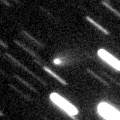
|
Now it is 16.0 mag (Sept. 8, Roberto Haver). It looks cometary. It is observable at 15.5 mag in good condition from October to November.
Date(TT) R.A. (2000) Decl. Delta r Elong. m1 Best Time(A, h)
Sept.21 5 51.01 20 27.8 2.223 2.432 89 16.1 4:22 (299, 65)
Sept.28 5 39.09 19 11.6 2.074 2.444 99 16.0 4:27 (323, 71)
|
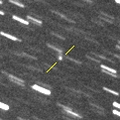
|
Now it is 16.5 mag (July 27, Kevin Hills). It will brighten up to 14 mag in winter. It stays observable for a long time in the Southern Hemisphere, although it becomes low in November. In the Northern Hemisphere, it is not observable for a long time until August in 2020.
Date(TT) R.A. (2000) Decl. Delta r Elong. m1 Best Time(A, h)
Sept.21 14 55.77 -41 35.4 3.003 2.642 59 16.1 19:23 ( 44, -8)
Sept.28 14 58.80 -42 43.7 3.036 2.591 54 16.0 19:13 ( 45,-11)
|
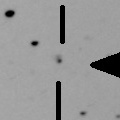
|
It looks cometary on the LCO (CTIO) image on Aug. 21. Now it is 15.7 mag (Aug. 28, Taras Prystavski). It is observable in excellent condition in the Southern Hemisphere. In the Northern Hemisphere, it locates extremely low for a while.
Date(TT) R.A. (2000) Decl. Delta r Elong. m1 Best Time(A, h)
Sept.21 20 8.77 -41 45.0 5.917 6.418 115 16.1 20:09 ( 0, 13)
Sept.28 20 2.85 -41 13.9 6.028 6.418 108 16.1 19:36 ( 0, 14)
|
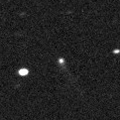
|
Now it is 16.0 mag (Sept. 1, Toshihiko Ikemura, Hirohisa Sato). It stays 15-16 mag for a long time until 2021.
Date(TT) R.A. (2000) Decl. Delta r Elong. m1 Best Time(A, h)
Sept.21 20 20.61 -30 34.5 4.368 4.976 122 16.2 20:21 ( 0, 25)
Sept.28 20 14.97 -29 40.1 4.450 4.952 114 16.2 19:48 ( 0, 25)
|

|
It was observed in the SOHO spacecraft images in 2008 and 2014. It will approach to Sun down to 0.067 a.u. on Oct. 9. It is observable in the evening low sky until late September. But it must be extremely faint.
Date(TT) R.A. (2000) Decl. Delta r Elong. m1 Best Time(A, h)
Sept.21 14 34.45 -15 37.5 0.757 0.695 43 17.8 19:23 ( 67, 5)
Sept.28 14 7.00 -11 13.1 0.775 0.499 29 16.4 19:13 ( 77, -1)
|
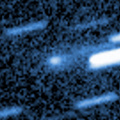
|
First return of a new periodic comet which brightened up to 16.5 mag in 2009. Now it is 16.2 mag (Sept. 11, Ken-ichi Kadota). It stays 16.5 mag until October. It is observable in good condition in the Northern Hemisphere. It locates low in the Southern Hemisphere.
Date(TT) R.A. (2000) Decl. Delta r Elong. m1 Best Time(A, h)
Sept.21 8 0.74 21 4.6 1.457 1.283 59 16.4 4:22 (271, 40)
Sept.28 8 24.18 18 59.3 1.456 1.299 60 16.5 4:27 (275, 41)
|
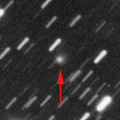
|
Now it is 16.3 mag (Sept. 1, Toshihiko Ikemura, Hirohisa Sato). It is expected to be observable at 5-6 mag for a long time from 2022 to 2023. In the Northern Hemisphere, it is not observable at the highlight from 2022 summer to 2023 summer. In the Southern Hemisphere, it stays unobservable for a while. But it will be observable in good condition at the highlight.
Date(TT) R.A. (2000) Decl. Delta r Elong. m1 Best Time(A, h)
Sept.21 17 7.43 51 47.5 10.903 10.819 82 16.5 19:23 (135, 61)
Sept.28 17 8.36 51 5.0 10.885 10.771 80 16.5 19:13 (132, 58)
|
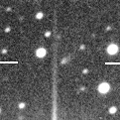
|
Now it is 16.6 mag (Sept. 2, Toshihiko Ikemura, Hirohisa Sato). It is observable at 16.5 mag in good condition from August to September. It will be fainter than 18 mag in November.
Date(TT) R.A. (2000) Decl. Delta r Elong. m1 Best Time(A, h)
Sept.21 0 4.07 6 17.3 1.512 2.511 171 16.6 0:08 ( 0, 62)
Sept.28 23 49.76 0 42.5 1.547 2.545 173 16.7 23:21 ( 0, 55)
|
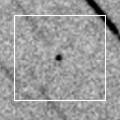
|
It passed the perihelion on July 2. Then it must have brightened up to 13 mag, but it was not observable around that time. In the Northern Hemisphere, it stays observable in excellent condition until December when it becomes fainter than 18 mag. In the Southern Hemisphere, it stays locating low.
Date(TT) R.A. (2000) Decl. Delta r Elong. m1 Best Time(A, h)
Sept.21 3 54.32 53 33.6 0.940 1.553 105 16.7 3:59 (180, 71)
Sept.28 3 24.98 54 9.2 0.925 1.625 114 16.6 3:02 (180, 71)
|

|
Now it is 18.4 mag (Aug. 1, iTelescope Observatory, Siding Spring). It will brighten up to 16 mag in autumn. It is observable in good condition in the Southern Hemisphere. It locates somewhat low in the Northern Hemisphere.
Date(TT) R.A. (2000) Decl. Delta r Elong. m1 Best Time(A, h)
Sept.21 18 48.55 -31 1.5 1.414 1.908 102 16.7 19:23 ( 8, 24)
Sept.28 18 58.34 -29 26.8 1.459 1.887 98 16.6 19:13 ( 10, 25)
|

|
Fading now. Now it is 15.8 mag (Aug. 24, Thomas Lehmann). In the Southern Hemisphere, it stays observable for a long time until it fades out. In the Northern Hemisphere, it will not be observable after this.
Date(TT) R.A. (2000) Decl. Delta r Elong. m1 Best Time(A, h)
Sept.21 6 45.65 -39 19.6 5.051 4.977 80 16.8 4:22 (332, 8)
Sept.28 6 44.72 -41 7.2 5.044 5.029 83 16.8 4:27 (339, 10)
|
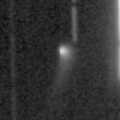
|
Now it is 16.8 mag (Aug. 2, Charles Morris). It will be fading after this. In the Northern Hemisphere, it stays observable in good condition for a long time. In the Southern Hemisphere, it stays extremely low for a long time.
Date(TT) R.A. (2000) Decl. Delta r Elong. m1 Best Time(A, h)
Sept.21 3 34.55 49 50.6 3.562 4.023 110 16.8 3:38 (180, 75)
Sept.28 3 21.23 49 30.1 3.490 4.059 118 16.8 2:58 (180, 75)
|

|
Now it is 18.7 mag (Sept. 17, Michael Jager). It will brighten very rapidly, and it will brighten up to 14 mag in winter. It is observable in excellent condition in the Northern Hemisphere. It locates low in the Southern Hemisphere.
Date(TT) R.A. (2000) Decl. Delta r Elong. m1 Best Time(A, h)
Sept.21 2 19.22 44 7.6 1.194 1.943 124 17.2 2:23 (180, 81)
Sept.28 2 22.46 45 17.8 1.115 1.906 128 16.8 1:58 (180, 80)
|
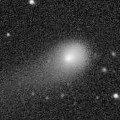
|
Fading. It stays 17 mag from autumn to winter. It is observable in good condition in the Northern Hemisphere. It locates low in the Southern Hemisphere.
Date(TT) R.A. (2000) Decl. Delta r Elong. m1 Best Time(A, h)
Sept.21 9 18.32 25 16.8 6.824 6.142 44 16.8 4:22 (256, 26)
Sept.28 9 19.52 24 57.3 6.776 6.185 50 16.9 4:27 (260, 32)
|

|
It approached to Earth down to 0.3 a.u. in mid February, and brightened up to 5.5 mag (Feb. 13, Juan Jose Gonzalez). Now it is fading. It has already faded down to 17.1 mag (Sept. 13, Ken-ichi Kadota).
Date(TT) R.A. (2000) Decl. Delta r Elong. m1 Best Time(A, h)
Sept.21 3 43.43 43 22.2 2.751 3.260 111 16.9 3:47 (180, 82)
Sept.28 3 27.17 43 27.2 2.710 3.333 120 17.0 3:04 (180, 81)
|
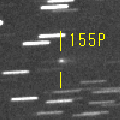
|
Now it is 17.1 mag (Sept. 14, Ken-ichi Kadota). It brightens rapidly, and it will be observable at 15 mag in good condition in winter. It locates somewhat low in the Southern Hemisphere.
Date(TT) R.A. (2000) Decl. Delta r Elong. m1 Best Time(A, h)
Sept.21 7 34.72 20 14.6 2.084 1.899 65 17.3 4:22 (276, 45)
Sept.28 7 53.07 19 47.9 2.009 1.877 67 17.0 4:27 (279, 48)
|
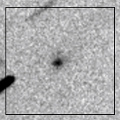
|
Now it is 17.3 mag (Sept. 11, Ken-ichi Kadota). The orbit is extremely hyperbolic with e=3.4. It seems to be a first interstellar comet in history. It brightens up to 15 mag in December. In the Northern Hemisphere, it stays observable in good condition until early December. Then it will be getting lower, and it will be unobservable in mid January. In the Southern Hemisphere, it is not observable for a while. But it will appear in the morning sky in late October, then it will be observable in excellent condition.
Date(TT) R.A. (2000) Decl. Delta r Elong. m1 Best Time(A, h)
Sept.21 9 7.77 26 56.1 3.242 2.659 46 17.3 4:22 (256, 29)
Sept.28 9 20.82 24 20.6 3.091 2.561 49 17.0 4:27 (261, 32)
|
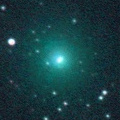
|
It brightened up to 11 mag in late 2018. Now it is 17.1 mag (Sept. 14, Ken-ichi Kadota). It will be fainter than 18 mag in November. It is observable in excellent condition in the Northern Hemisphere. It locates extremely low in the Southern Hemisphere.
Date(TT) R.A. (2000) Decl. Delta r Elong. m1 Best Time(A, h)
Sept.21 3 55.73 49 22.3 3.425 3.847 107 17.1 3:59 (180, 76)
Sept.28 3 51.11 49 5.1 3.392 3.911 114 17.2 3:27 (180, 76)
|
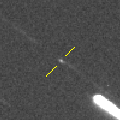
|
First return of a new periodic comet which brightened up to 18 mag in 2014. Now it is 17.5 mag (Sept. 13, Ken-ichi Kadota). It stays 17 mag until November. It is observable in good condition in the Northern Hemisphere. It locates extremely low in the Southern Hemisphere.
Date(TT) R.A. (2000) Decl. Delta r Elong. m1 Best Time(A, h)
Sept.21 4 0.84 29 4.3 0.284 1.146 113 17.3 4:03 ( 0, 84)
Sept.28 4 44.06 34 5.6 0.282 1.129 109 17.2 4:18 ( 0, 89)
|
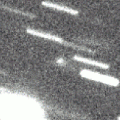
|
Now it is 19.2 mag (Sept. 9, Toshihiko Ikemura, Hirohisa Sato). It brightens up to 16.5 mag from October to December. It is observable in good condition in the Northern Hemisphere. It locates low in the Southern Hemisphere.
Date(TT) R.A. (2000) Decl. Delta r Elong. m1 Best Time(A, h)
Sept.21 6 51.58 12 8.3 1.587 1.642 74 17.4 4:22 (294, 49)
Sept.28 7 8.91 13 25.5 1.519 1.629 77 17.3 4:27 (297, 52)
|
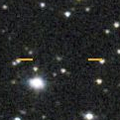
|
Now it is 17.6 mag (Sept. 7, Ken-ichi Kadota). It will stay at 14 mag for a long time from 2021 to 2022. In the Northern Hemisphere, it stays observable in good condition while brightening gradually, although it becomes low in December and January. In the Southern Hemisphere, it locates extremely low now, and it will be unobservable soon.
Date(TT) R.A. (2000) Decl. Delta r Elong. m1 Best Time(A, h)
Sept.21 18 23.74 43 18.2 7.420 7.579 95 17.5 19:23 (130, 76)
Sept.28 18 22.38 42 6.3 7.435 7.543 92 17.5 19:13 (121, 73)
|

|
Now it is fading. In 2019, it is observable at 17.5 mag in good condition in autumn.
Date(TT) R.A. (2000) Decl. Delta r Elong. m1 Best Time(A, h)
Sept.21 2 54.13 11 6.2 3.377 4.126 132 17.7 2:57 ( 0, 66)
Sept.28 2 51.64 10 56.7 3.319 4.140 140 17.6 2:27 ( 0, 66)
|
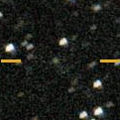
|
Now it is 17.5 mag (Sept. 1, Toshihiko Ikemura, Hirohisa Sato). It will brighten up to 12 mag in winter in 2022.
Date(TT) R.A. (2000) Decl. Delta r Elong. m1 Best Time(A, h)
Sept.21 22 15.76 47 20.2 7.151 7.802 127 17.7 22:15 (180, 78)
Sept.28 22 12.30 47 3.1 7.108 7.757 127 17.7 21:44 (180, 78)
|
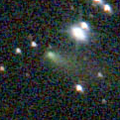
|
It brightened up to 13.0 mag in May (May 15, Thomas Lehmann). Now it is fading. It has already faded down to 17.6 mag (Sept. 1, Toshihiko Ikemura, Hirohisa Sato). It is observable in excellent condition in the Northern Hemisphere. It locates extremely low in the Southern Hemisphere.
Date(TT) R.A. (2000) Decl. Delta r Elong. m1 Best Time(A, h)
Sept.21 1 1.78 42 52.9 1.533 2.338 133 17.8 1:06 (180, 82)
Sept.28 0 56.81 41 6.4 1.550 2.402 139 18.1 0:33 (180, 84)
|
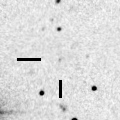
|
It is observable at 17-18 mag for a long time from late 2019 to early 2021.
Date(TT) R.A. (2000) Decl. Delta r Elong. m1 Best Time(A, h)
Sept.21 3 31.94 2 28.8 4.647 5.282 124 17.9 3:35 ( 0, 58)
Sept.28 3 30.92 2 12.7 4.554 5.269 131 17.8 3:07 ( 0, 57)
|

|
First return of a new periodic comet which brightened up to 17 mag in 2006. It has not been recovered yet in this apparition. It will brighten up to 18 mag in autumn. It is observable in good condition in the Southern Hemisphere. It locates extremely low in the Northern Hemisphere.
Date(TT) R.A. (2000) Decl. Delta r Elong. m1 Best Time(A, h)
Sept.21 17 14.71 -35 56.2 2.418 2.508 83 17.9 19:23 ( 26, 13)
Sept.28 17 26.57 -35 33.5 2.483 2.494 78 17.9 19:13 ( 27, 13)
|

|
First return of a new periodic comet discovered in 2006. It has not been recovered yet in this apparition. It will brighten up to 16.5 mag in 2020 spring. But it is not observable at that time. It will be observable at 18 mag in 2019 autumn and 2020 autumn.
Date(TT) R.A. (2000) Decl. Delta r Elong. m1 Best Time(A, h)
Sept.21 18 48.09 -12 4.0 2.212 2.645 104 17.9 19:23 ( 11, 42)
Sept.28 18 51.60 -12 57.4 2.253 2.595 98 17.9 19:13 ( 16, 41)
|

|
Now it is bright as 17 mag (Aug. 23, Hidetaka Sato). Hidetaka Sato reported it looks cometary with coma. It will be getting lower gradually after this.
Date(TT) R.A. (2000) Decl. Delta r Elong. m1 Best Time(A, h)
Sept.21 17 56.12 -11 47.4 4.475 4.612 91 19.7 19:23 ( 28, 39)
Sept.28 17 59.35 -12 5.7 4.577 4.610 85 19.8 19:13 ( 31, 37)
|
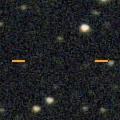
|
Now it is very faint as 20.5 mag (Sept. 12, Francois Kugel). It brightened up to 15.5 mag in 1997, and 17 mag in 2008, however, it is much fainter in this apparition.
Date(TT) R.A. (2000) Decl. Delta r Elong. m1 Best Time(A, h)
Sept.21 1 32.86 20 3.4 2.421 3.311 147 20.1 1:36 ( 0, 75)
Sept.28 1 29.92 19 37.3 2.381 3.314 154 20.1 1:06 ( 0, 75)
|

|
Now it is 20.15 mag (Aug. 31, Fornari-Ferrin). It will approaches to Earth down to 0.09 a.u. in early January. It will be obesrvable in excellent condition in the Northern Hemisphere. But it will be 17.5 mag at best. In the Southern Hemisphere, it will not be observable at the high light.
Date(TT) R.A. (2000) Decl. Delta r Elong. m1 Best Time(A, h)
Sept.21 23 22.46 -21 10.7 0.573 1.552 158 21.0 23:21 ( 0, 34)
Sept.28 23 11.33 -22 39.7 0.529 1.487 150 20.9 22:43 ( 0, 32)
|
|
![]()
 29P/Schwassmann-Wachmann 1
29P/Schwassmann-Wachmann 1 C/2019 A9 ( PanSTARRS )
C/2019 A9 ( PanSTARRS ) 68P/Klemola
68P/Klemola C/2018 A6 ( Gibbs )
C/2018 A6 ( Gibbs ) 78P/Gehrels 2
78P/Gehrels 2 C/2016 M1 ( PanSTARRS )
C/2016 M1 ( PanSTARRS ) C/2017 B3 ( LINEAR )
C/2017 B3 ( LINEAR ) C/2017 M4 ( ATLAS )
C/2017 M4 ( ATLAS ) 101P/Chernykh
101P/Chernykh C/2019 K5 ( Young )
C/2019 K5 ( Young ) C/2018 F4 ( PanSTARRS )
C/2018 F4 ( PanSTARRS ) 261P/Larson
261P/Larson 2018 DO4
2018 DO4 C/2019 K1 ( ATLAS )
C/2019 K1 ( ATLAS ) A/2017 U7
A/2017 U7 C/2019 K7 ( Smith )
C/2019 K7 ( Smith ) P/2008 Y12 = P/2014 K3 ( SOHO )
P/2008 Y12 = P/2014 K3 ( SOHO ) P/2019 R1 ( Boattini )
P/2019 R1 ( Boattini ) C/2017 K2 ( PanSTARRS )
C/2017 K2 ( PanSTARRS ) C/2019 K4 ( Ye )
C/2019 K4 ( Ye ) (3200) Phaethon
(3200) Phaethon 160P/LINEAR
160P/LINEAR C/2016 N6 ( PanSTARRS )
C/2016 N6 ( PanSTARRS ) C/2018 A3 ( ATLAS )
C/2018 A3 ( ATLAS ) 114P/Wiseman-Skiff
114P/Wiseman-Skiff C/2015 O1 ( PanSTARRS )
C/2015 O1 ( PanSTARRS ) C/2018 Y1 ( Iwamoto )
C/2018 Y1 ( Iwamoto ) 155P/Shoemaker 3
155P/Shoemaker 3 C/2019 Q4 ( Borisov )
C/2019 Q4 ( Borisov ) C/2018 L2 ( ATLAS )
C/2018 L2 ( ATLAS ) P/2019 O1 ( Kowalski )
P/2019 O1 ( Kowalski ) 76P/West-Kohoutek-Ikemura
76P/West-Kohoutek-Ikemura C/2018 U1 ( Lemmon )
C/2018 U1 ( Lemmon ) 65P/Gunn
65P/Gunn C/2019 L3 ( ATLAS )
C/2019 L3 ( ATLAS ) C/2019 D1 ( Flewelling )
C/2019 D1 ( Flewelling ) 173P/Mueller 5
173P/Mueller 5 P/2006 H1 ( McNaught )
P/2006 H1 ( McNaught ) P/2006 W1 ( Gibbs )
P/2006 W1 ( Gibbs ) 2019 LD2
2019 LD2 200P/Larsen
200P/Larsen 289P/Blanpain
289P/Blanpain![]()





































